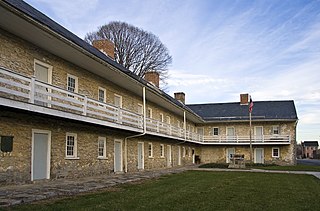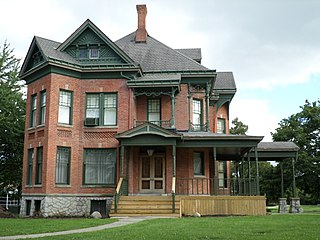
Boulder is a town in and the county seat of Jefferson County, Montana, United States. It is on the north bank of the Boulder River between Butte and Helena, slightly east of the Continental Divide, at the intersection of Interstate 15 and Montana Highway 69. The population was 1,201 at the 2020 census. It is part of the Helena Micropolitan Statistical Area, which includes all of Lewis and Clark and Jefferson counties; its population is 83,058 according to the 2020 Census.

Thomas Hopkins Gallaudet was an American educator. Along with Laurent Clerc and Mason Cogswell, he co-founded the first permanent institution for the education of the deaf in North America, and he became its first principal. When opened on April 15, 1817, it was called the "Connecticut Asylum for the Education and Instruction of Deaf and Dumb Persons," but it is now known as the American School for the Deaf.

This is a list of properties and historic districts in Montana that are listed on the National Register of Historic Places. The state's more than 1,100 listings are distributed across all of its 56 counties.

The American School for the Deaf (ASD) originally The American Asylum, At Hartford, For The Education And Instruction Of The Deaf And Dumb is the oldest permanent school for the deaf in the United States, and the first school for children with disabilities anywhere in the western hemisphere. It was founded April 15, 1817, in West Hartford, Connecticut, by Thomas Hopkins Gallaudet, Dr. Mason Cogswell, and Laurent Clerc and became a state-supported school later that year.

The Kentucky School for the Deaf (KSD), located in Danville, Kentucky, United States, is a school that provides education to deaf and hard-of-hearing children from elementary through high school levels. Founded in 1823, it was the first school for the deaf west of the Allegheny Mountains. Jacobs Hall, its oldest surviving building, was designated a National Historic Landmark in recognition of this history.

The California School for the Blind is a public educational institution for blind children, K-12, located in Fremont, California. Its campus is located next to the California School for the Deaf.

The Virginia School for the Deaf and the Blind, located in Staunton, Virginia, United States, is an institution for educating deaf and blind children, first established in 1839 by an act of the Virginia General Assembly. The school accepts children aged between 2 and 22 and provides residential accommodation for those students aged 5 and over who live outside a 35-mile radius of the school
The Tennessee Schools for the Deaf (TSD) is a state-operated residential and day school for deaf and hard-of-hearing students who reside in the state of Tennessee ranging from pre-kindergarten to grade 12 also includes a post-secondary transition/occupational program. It is located in Knoxville, Tennessee within the historic Island Home Park neighborhood.

Hessian Barracks, formerly known as Frederick Barracks, is an historic barracks building located in Frederick, Maryland. The State of Maryland contracted to build a barracks in the summer of 1777, but it was not completed until 1781. There were two L-shaped buildings built on the site, but one was demolished in 1871. The building is a two-story stone structure with gallery porches and a gable roof. Hessian Barracks was listed on the National Register of Historic Places in 1971.

The Pennsylvania School for the Deaf is the third-oldest school of its kind in the United States. Its founder, David G. Seixas (1788–1864), was a Philadelphia crockery maker-dealer who became concerned with the plight of impoverished deaf children that he observed on the city's streets. The current school building is listed by the National Register of Historic Places, and two former campuses are similarly recognized.

The Gallaudet College Historic District is a National Historic Landmark District encompassing the historic early campus of Gallaudet University in Washington, D.C.. Gallaudet is the first school of higher education to be devoted to the education of the deaf and hard of hearing. Its campus was planned by Frederick Law Olmsted and Calvert Vaux, and its Gothic buildings were designed by Frederick Withers. The main Gallaudet College building was listed on the National Register of Historic Places in 1966 and designated a National Historic Landmark in 1965. The landmarked area was increased to cover the southern part of the campus, and was renamed as a historic district in 1974.

The South Carolina School for the Deaf and the Blind is a school in unincorporated Spartanburg County, South Carolina, United States, near Spartanburg and with a Spartanburg postal address. It was founded in 1849 by the Reverend Newton Pinckney Walker as a private school for students who were deaf. The School for the Blind was established in 1855, and the school became state funded in 1856.

This is a list of the National Register of Historic Places listings in Deaf Smith County, Texas.

Cristo Rey Columbus High School is a private, Roman Catholic, co-educational high school in Columbus, Ohio, United States. It was established in 2013 and is located in the Roman Catholic Diocese of Columbus. It follows the Cristo Rey work-study model of education for students from low-income families.

John C. Paulsen was an American architect who designed buildings in Montana, two of which are listed on the National Register of Historic Places. He was rumoured to have faked his own death and lived off his life insurance in Germany.

The First Johnson County Asylum is a historic building located on the far west side of Iowa City, Iowa, United States. The first facility Johnson County built to care for paupers and the mentally ill was a four-room cabin in 1855. Two wings were added to the original building six years later. All that remains of this structure is this wing that housed the mentally ill. The single-story wood-frame structure with a gable roof was used by the county for this purpose until 1886 when a new facility was completed. It was initially thought that it was built in 1859, but later research revealed that it was built in 1861 and that it was moved a short distance to this location in 1888. This building served for many years as a hog building on the Johnson County Poor Farm. It is now part of an education-based farm program called Grow:Johnson County. The building was individually listed on the National Register of Historic Places in 1978. In 2014 it was included as a contributing property in the Johnson County Poor Farm and Asylum Historic District.

The Johnson County Poor Farm and Asylum Historic District is a nationally recognized historic district located in Iowa City, Iowa, United States. It was listed on the National Register of Historic Places in 2014. At the time of its nomination it consisted of 11 resources, which included three contributing buildings, two contributing sites, four contributing structures and two non-contributing buildings. It also includes the First Johnson County Asylum, which was individually listed on the National Register. The remaining buildings and structures are agricultural in nature, and were built from the late 19th-century to the early 20th-century.

The Montana State Training School Historic District was listed on the National Register of Historic Places in 2014. It is a complex of buildings set around an oval green and a central administrative building named Griffin Hall. Griffin Hall was built in 1912 and is the oldest building. Many former buildings of the complex were demolished in the 1970s and 1980s.

The Superintendent's Cottage at the Michigan School for the Deaf is a single-family home located on Beaver Drive, on the Michigan School for the Deaf campus, in Flint, Michigan, It was listed on the National Register of Historic Places in 1975.

The Ohio Institution for the Deaf and Dumb was a deaf school campus in Downtown Columbus, Ohio. The school, today known as the Ohio School for the Deaf, sat on the present-day Topiary Park grounds in the modern-day Discovery District. The main school building was gutted by a fire on October 2, 1981, though an existing building still stands as Cristo Rey Columbus High School. That remaining building is listed on the National Register of Historic Places and Columbus Register of Historic Properties.





















